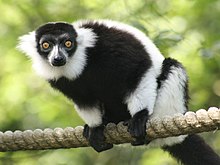Black and white vari
| Black and white vari | ||||||||||||
|---|---|---|---|---|---|---|---|---|---|---|---|---|

Black and White Vari ( Varecia variegata ) |
||||||||||||
| Systematics | ||||||||||||
|
||||||||||||
| Scientific name | ||||||||||||
| Varecia variegata | ||||||||||||
| ( Kerr , 1792) |
The black and white Vari ( Varecia variegata ) is an on Madagascar living primate species from the group of lemurs .
features
Black and white varis reach a head body length of 43 to 57 centimeters, their tail is 60 to 65 centimeters long. Their weight is 2.6 to 4.1 kilograms. The head is characterized by the long, dog-like snout with the long tongue, as well as by the tufts of ears and the ruff. The long tail is densely hairy. Their fur is patterned in black and white, the coloration varies according to the area of distribution. Generally, the tail, hands and feet, the inside of the limbs, the shoulders, the face, and the top of the head are black, while parts of the back, flanks, and the outside of the hind legs are white. The tufts of ears and the ruff are also white. From north to south the proportion of white on the back increases and the proportion of black decreases; these differences have led to the description of three subspecies, the taxonomic status of which is however controversial. In the northern subspecies, Varecia varecia subcincta (belt vari), the back is predominantly black, only the shoulder region is white. In the middle subspecies, V. v. editorum , the back is predominantly white with the exception of a saddle-shaped drawing on the shoulders, and in the southern subspecies V. v. variegata , only small spots on the shoulders are black and the rest of the back and trunk are white.
distribution and habitat
Like all lemurs, black and white varis occur only in Madagascar , where they inhabit the rainforests in the east of the island. They occur from sea level up to 1,300 meters above sea level, their area of distribution is now much smaller and fragmented.
Lifestyle and diet
These primates are tree dwellers who are mainly active during the day, especially in the early morning and late afternoon. They move slowly in the branches, but can also bridge distances by jumping. The social behavior is variable, in some areas they mainly live in family groups of 2 to 5 animals, but sometimes they also form larger groups of up to 16 animals. They communicate with loud calls that can be heard mostly in the evening.
The diet of the black and white Varis consists mainly of fruits, but they also consume leaves and nectar. When foraging for food, they sometimes cling to their feet and hang upside down in the trees to get to hard-to-reach fruits. With their long snouts, they also lick nectar, and they play an important role in pollination, for example in the travelers' tree .
Reproduction
Female varis, unlike other common makis, have three pairs of teats. After a gestation period of 90 to 100 days, the female usually gives birth to twins in September or October, but in some cases up to four young animals. The birth takes place in a well hidden nest in the trees, later the young are also "parked" there when the mother goes looking for food. After four to five months they are weaned and after two to three years they are sexually mature. Life expectancy in human care can be over 25 years.
threat
Black and white Varis are among the endangered species, the reasons for this on the one hand in the destruction of their habitat through slash and burn, deforestation and mining. On the other hand, they are one of the most frequently hunted lemur species, their large size, daytime activity and loud calls make them easy targets for hunters. The IUCN estimates that the total population has declined by over 80% in the last 27 years and lists the species as " critically endangered ".
In Germany the species is kept in eleven zoos.
literature
- Nick Garbutt: Mammals of Madagascar. A Complete Guide. Yale University Press, New Haven CT 2007, ISBN 978-0-300-12550-4 .
- Thomas Geissmann : Comparative Primatology. Springer-Verlag, Berlin et al. 2002, ISBN 3-540-43645-6 .
- Don E. Wilson, DeeAnn M. Reeder (Eds.): Mammal Species of the World. A taxonomic and geographic Reference. Johns Hopkins University Press, Baltimore MD 2005, ISBN 0-8018-8221-4 .
supporting documents
Web links
- Varecia variegata onthe IUCN Red List of Threatened Species . Retrieved April 6, 2009.


